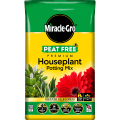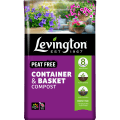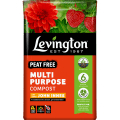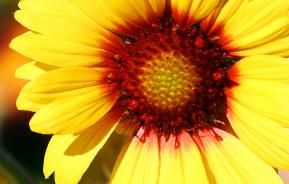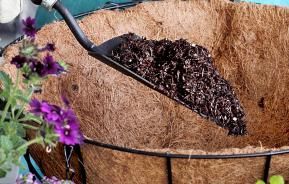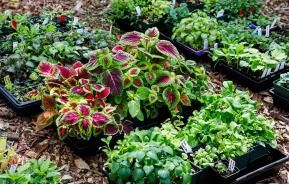Our gardening for beginners guide will set you on the right path if you're new to gardening and don't know your secateurs from your long-handled loppers.
Know your soil type
Whether you’re a seasoned professional or a complete beginner, a good garden starts with knowing your soil. Luckily, this is easier than it sounds. A simple soil test will give you a good idea what kind of soil you're working with - and you don’t have to be a scientist to carry it out.
First, take a handful of soil. Avoid carrying out your test in periods of drought or prolonged heavy rainfall - but if the soil is dehydrated, you can add a couple of drops of water.
Now, pretend you're holding a handful of plasticine, and begin squeezing it into one lump. Next, try flattening the lump into a flat ribbon about half a centimetre thick. If it crumbles, chances are you're dealing with sandy soil. If it holds its shape like modelling clay, you've got yourself a (you've guessed it) clay soil. If it’s somewhere in between, you've got yourself a loam-based soil.
But what does this actually mean? Well, clay soil is slow to drain, which can present a major problem for plant growth. Sandy soils represent the other extreme - excellent drainage, but this can mean that they're prone to drying out and may have difficulty retaining nutrients. Loam is the best of both worlds; the ‘just right’ of soils, containing a mixture of both.
While in reality, the soil in many gardens will fall somewhere along the spectrum, having a basic understanding of your garden's soil type will help you begin to plan your planting. For example, raised beds are great for clay soils when growing fruit and veg as they offer improved drainage, and sandy soils will benefit from the addition of a controlled release plant food.
Plan ahead
The gardener's schedule is heavily influenced by the calendar, so an unprepared beginner will often perform tasks in reaction to the changing seasons, which is important when leaving winter and going into spring. The savvy beginner, on the other hand, will anticipate these changes in advance.
For example, ensuring your soil is in prime condition for spring requires preparation the previous autumn. Summer’s lush green lawn was raked free from leaves and given one last mow before the winter frost set in. Get yourself a diary or calendar and write in the tasks you need to do in the oncoming months - it’ll make your job easier in the long term.
Choosing the right tools for the job
As a beginner, the gardening equipment and tools section of your local DIY store can seem a little daunting, so start with the basics. You don't need a lot to start out with, but the key is to buy individual items that are perfectly suited to you.
First, a good fork and spade will stand you in good stead for loosening, digging and spreading soil. If fazed by the many options on offer, go for whichever you find most comfortable to lift. Buying online to find a good deal? It might be a good idea to visit a physical shop first to try out a variety of makes and models before committing to buy.
Next, you'll need tools for cutting and pruning. Secateurs are used for thinner stems and twigs. Again, be sure to choose a pair that feel comfortable and manageable in your hand. If you've inherited a hedge to maintain, you'll also need a pair of long-handled shears. If you're not especially strong, heavier models can be tiring to use, so it's worth spending a little more on a lightweight variety.
For planting, you’ll need a hand trowel. A shorter handle is generally fine, but consider a longer handled version if there are areas in your garden you'll find difficult to reach with a standard model.
Finally, don't forget to pick up a good pair of gardening gloves. And by 'good', we mean a pair that's strong and durable without being bulky. Gloves will guard against scratches, splinters and allergic reactions. If you find it difficult to use your tools with your gloves on, chances are that yours don't fit correctly. A well-fitting pair will protect your hands from blisters, making it easier to use tools for longer periods.
Always read the label…
When choosing plants, that is. As a beginner browsing your local garden centre, you might feel cowed by your lack of knowledge. Luckily, most plants and bulbs will come with guidance on the label to let you know what kind of conditions the species is suited for - which soil type, for example, or whether the plant requires shade.
Don’t forget to have fun!
Speak to any green-fingered gardener, and you’ll notice one thing: they’re passionate about what they do. While gardening is part of your home’s general upkeep, it’s also a hobby - and potentially one of the most rewarding.


